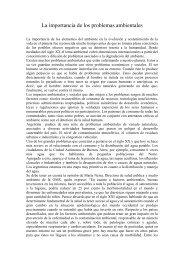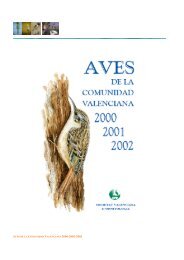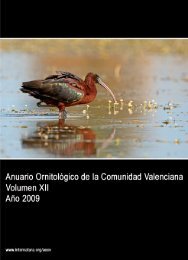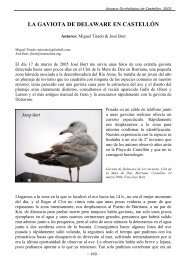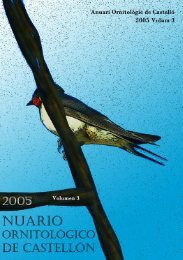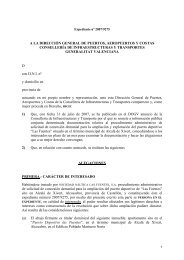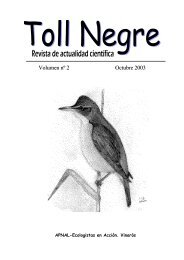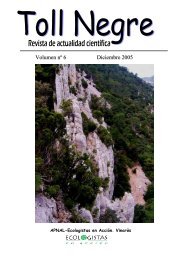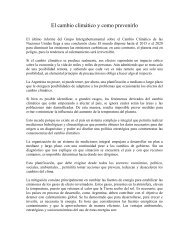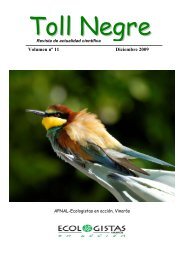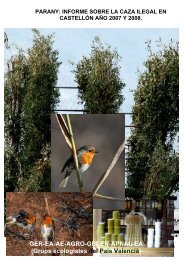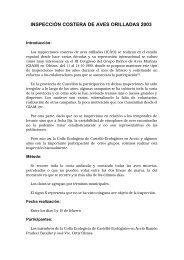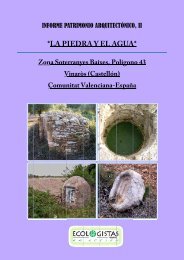ANUARIO ORNITOLÃGICO DE CASTELLÃN 2007 - InterNatura
ANUARIO ORNITOLÃGICO DE CASTELLÃN 2007 - InterNatura
ANUARIO ORNITOLÃGICO DE CASTELLÃN 2007 - InterNatura
You also want an ePaper? Increase the reach of your titles
YUMPU automatically turns print PDFs into web optimized ePapers that Google loves.
Anuario Ornitológico de Castellón. <strong>2007</strong><br />
altitude. The mean laying date was February 18 ± 16 days. Laying date was positively correlated<br />
with nest altitude, the coastal pairs laying earlier than those in mountainous regions. Pairs located<br />
at lower altitudes showed higher mean fecundity than those located at higher altitudes. There was<br />
no preference in mean orientation either in breeding performance or in relationship to nest altitude.<br />
We did not find a difference in breeding performance between territories classed as being at high<br />
density and those classed as being at low density. Conclusion The population has remained stable<br />
since the first national census was conducted 17 years ago. Our results could be explained in the<br />
light of the Habitat Heterogeneity Hypothesis. We suggest a differential reproductive success in<br />
relation to habitat heterogeneity.<br />
TAMAÑO POBLACIONAL Y PARÁMETROS<br />
REPRODUCTORES <strong>DE</strong>L ALIMOCHE COMÚN (NEOPHRON<br />
PERCNOPTERUS) EN LA PROVINCIA <strong>DE</strong> CASTELLÓN, ESTE<br />
<strong>DE</strong> LA PENÍNSULA IBÉRICA.<br />
Autor: LÓPEZ-LÓPEZ, P. & C. GARCÍA-RIPOLLÉS.<br />
Datos de contacto: lopez.pascual@gmail.com<br />
Tipo de comunicación: Artículo científico<br />
Referencia: Dugastella 4:49-52<br />
Fecha publicación: <strong>2007</strong><br />
Resumen: La población de Alimoche común en la Península Ibérica ha decaído en las últimas<br />
décadas hasta alcanzar valores de 1.320-1.480 parejas reproductoras según los últimos censos. En<br />
este trabajo se muestran algunos datos sobre el tamaño poblacional y los parámetros reproductores<br />
durante los años 2003 y 2004 así como una pequeña descripción de las principales características<br />
del emplazamiento de los lugares de cría de la especie. Un total de siete parejas reproductoras<br />
fueron localizadas en 2003 y nueve en 2004. Los parámetros reproductores fueron similares a los<br />
encontrados en otras áreas geográficas. La mayoría de nidos se emplazaron en orientaciones<br />
térmicamente favorables, y es destacable que la mayoría de las parejas estudiadas utilizaron cuevas<br />
para la instalación del nido. Dado el escaso número de parejas encontradas, se debe tener en cuenta<br />
la limitación de los resultados obtenidos y sus posibles inferencias. Si tenemos en cuenta el declive<br />
generalizado de la población de Alimoche en la Península Ibérica y el aumento detectado en<br />
nuestra provincia, estimamos necesario llevar a cabo estudios más detallados, así como la toma de<br />
medidas de conservación concretas para favorecer el mantenimiento de la especie en nuestro área<br />
de estudio.<br />
Abstract: The Iberian Egyptian Vulture's population has decreased in the last decades reaching<br />
1.320-1.480 reproductive pairs according to last censuses. In this paper, population size and<br />
reproductive performance are shown for 2003 and 2004. A brief description of main nest<br />
characteristics of the species is also exposed. Seven reproductive pairs were located in 2003 and<br />
nine in 2004. Breeding parameters were similar to those found in other geographic areas. Most<br />
nests were placed on thermic favourable orientations and inside caves. Due to breeding pair's<br />
scarce number, results obtained and possible inferences should be limited. If we consider the<br />
generalized Egyptian Vulture's population decay and the increase detected in our province, more<br />
detailed studies are necessary. Furthermore, specific conservation measures are needed in order to<br />
keep the species in our study area.<br />
- 217 -



